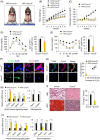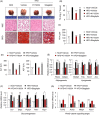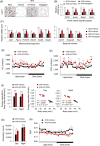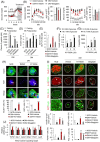Inhibition of CXXC5 function reverses obesity-related metabolic diseases
- PMID: 35384342
- PMCID: PMC8982507
- DOI: 10.1002/ctm2.742
Inhibition of CXXC5 function reverses obesity-related metabolic diseases
Abstract
Background: Metabolic diseases, including type 2 diabetes, have long been considered incurable, chronic conditions resulting from a variety of pathological conditions in obese patients. Growing evidence suggests the Wnt/β-catenin pathway is a major pathway in adipose tissue remodelling, pancreatic β-cell regeneration and energy expenditure through regulation of key metabolic target genes in various tissues. CXXC5-type zinc finger protein 5 (CXXC5) is identified negative feedback regulator of the Wnt/β-catenin pathway that functions via Dishevelled (Dvl) binding.
Methods: Expression level of CXXC5 was characterised in clinical samples and diabetes-induced mice model. Diabetes-induced mice model was established by using high-fat diet (HFD). HFD-fed mice treated with KY19334, a small molecule inhibiting CXXC5-Dvl protein-protein interaction (PPI), was used to assess the role of CXXC5 in metabolic diseases.
Results: Here, we show that CXXC5 is overexpressed with suppression of Wnt/β-catenin signalling in visceral adipose tissues of patients with obesity-related diabetes. Meanwhile, Cxxc5-/- mice fed an HFD exhibited resistance to metabolic dysregulation. KY19334 restores the lowered Wnt/β-catenin signalling and reverses metabolic abnormalities as observed in HFD-fed Cxxc5-/- mice. Administration of KY19334 on HFD-fed mice had a long-lasting glucose-controlling effect through remodelling of adipocytes and regeneration of pancreatic β-cells.
Conclusion: Overall, the inhibition of CXXC5 function by small molecule-mediated interference of Dvl binding is a potential therapeutic strategy for the treatment of obesity-related diabetes.
Keywords: CXXC5; Wnt/β-catenin pathway; adipose tissue remodelling; metabolic diseases; pancreatic β-cell regeneration.
© 2022 The Authors. Clinical and Translational Medicine published by John Wiley & Sons Australia, Ltd on behalf of Shanghai Institute of Clinical Bioinformatics.
Conflict of interest statement
The authors declare no competing interests exist.
Figures






Similar articles
-
Blockade of CXXC5-dishevelled interaction inhibits adipogenic differentiation, obesity, and insulin resistance in mice.Sci Rep. 2022 Nov 30;12(1):20669. doi: 10.1038/s41598-022-25315-x. Sci Rep. 2022. PMID: 36450849 Free PMC article.
-
Inhibition of CXXC5 function rescues Alzheimer's disease phenotypes by restoring Wnt/β-catenin signaling pathway.Pharmacol Res. 2023 Aug;194:106836. doi: 10.1016/j.phrs.2023.106836. Epub 2023 Jun 22. Pharmacol Res. 2023. PMID: 37355147
-
Metabolic improvement and liver regeneration by inhibiting CXXC5 function for non-alcoholic steatohepatitis treatment.Exp Mol Med. 2022 Sep;54(9):1511-1523. doi: 10.1038/s12276-022-00851-8. Epub 2022 Sep 16. Exp Mol Med. 2022. PMID: 36114279 Free PMC article.
-
Targeting of CXXC5 by a Competing Peptide Stimulates Hair Regrowth and Wound-Induced Hair Neogenesis.J Invest Dermatol. 2017 Nov;137(11):2260-2269. doi: 10.1016/j.jid.2017.04.038. Epub 2017 Jun 6. J Invest Dermatol. 2017. PMID: 28595998 Review.
-
CXXC5: A novel regulator and coordinator of TGF-β, BMP and Wnt signaling.J Cell Mol Med. 2019 Feb;23(2):740-749. doi: 10.1111/jcmm.14046. Epub 2018 Nov 27. J Cell Mol Med. 2019. PMID: 30479059 Free PMC article. Review.
Cited by
-
Signaling pathways in obesity: mechanisms and therapeutic interventions.Signal Transduct Target Ther. 2022 Aug 28;7(1):298. doi: 10.1038/s41392-022-01149-x. Signal Transduct Target Ther. 2022. PMID: 36031641 Free PMC article. Review.
-
Signal integrator function of CXXC5 in Cancer.Cell Commun Signal. 2025 Jan 14;23(1):25. doi: 10.1186/s12964-024-02005-x. Cell Commun Signal. 2025. PMID: 39806388 Free PMC article. Review.
-
CXXC5 function blockade promotes diabetic wound healing through stimulating fibroblast and vascular endothelial cell activation.Cell Commun Signal. 2025 Feb 25;23(1):108. doi: 10.1186/s12964-025-02097-z. Cell Commun Signal. 2025. PMID: 40001144 Free PMC article.
-
Blockade of CXXC5-dishevelled interaction inhibits adipogenic differentiation, obesity, and insulin resistance in mice.Sci Rep. 2022 Nov 30;12(1):20669. doi: 10.1038/s41598-022-25315-x. Sci Rep. 2022. PMID: 36450849 Free PMC article.
-
Inhibiting the cytosolic function of CXXC5 accelerates diabetic wound healing by enhancing angiogenesis and skin repair.Exp Mol Med. 2023 Aug;55(8):1770-1782. doi: 10.1038/s12276-023-01064-3. Epub 2023 Aug 1. Exp Mol Med. 2023. PMID: 37524876 Free PMC article.
References
MeSH terms
Substances
LinkOut - more resources
Full Text Sources
Medical
Molecular Biology Databases
